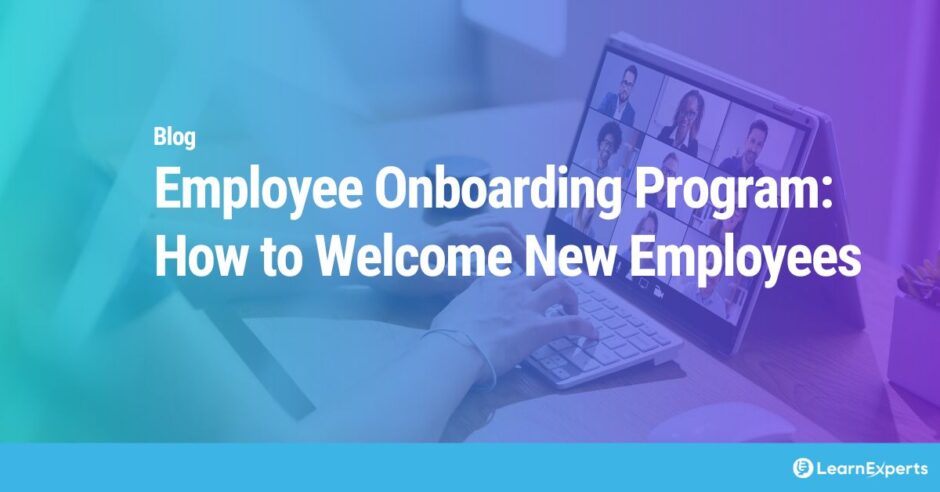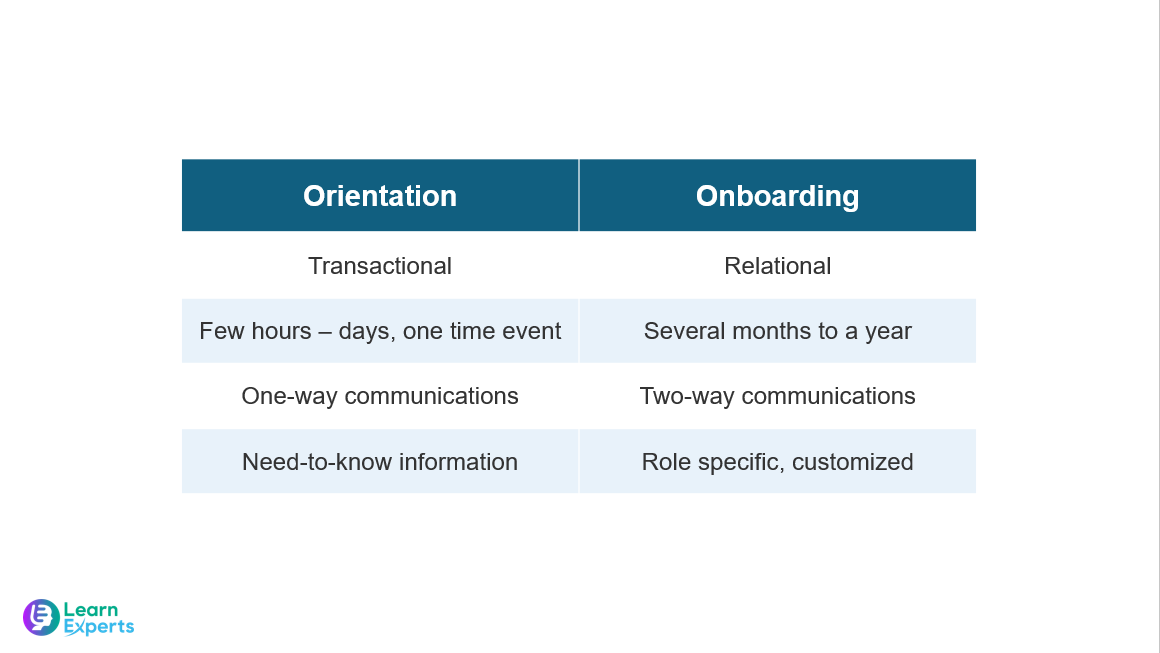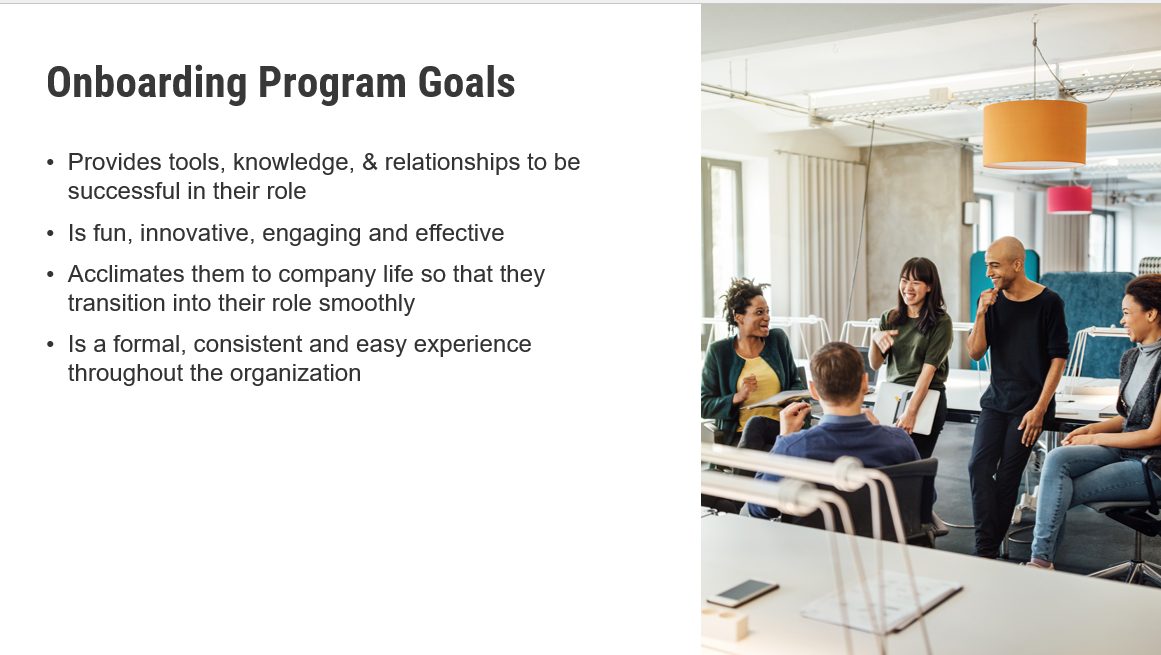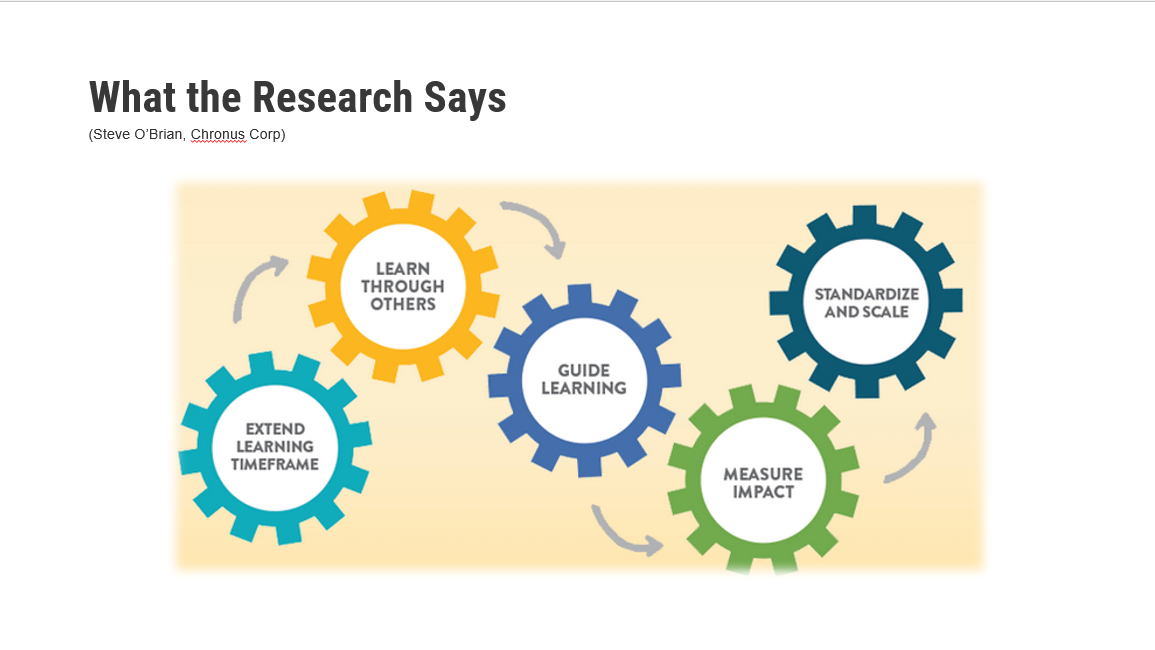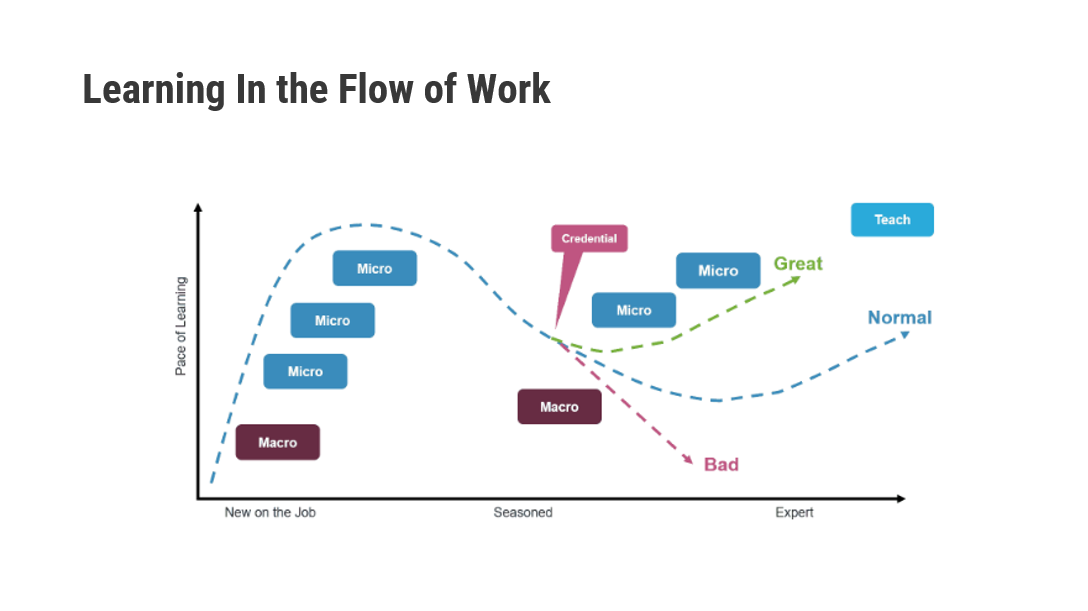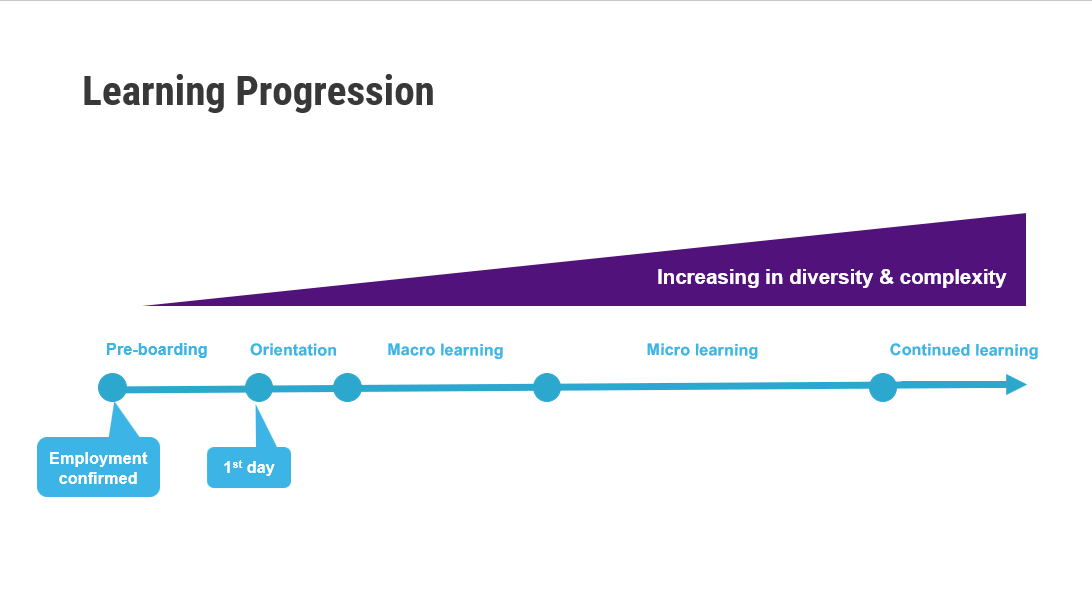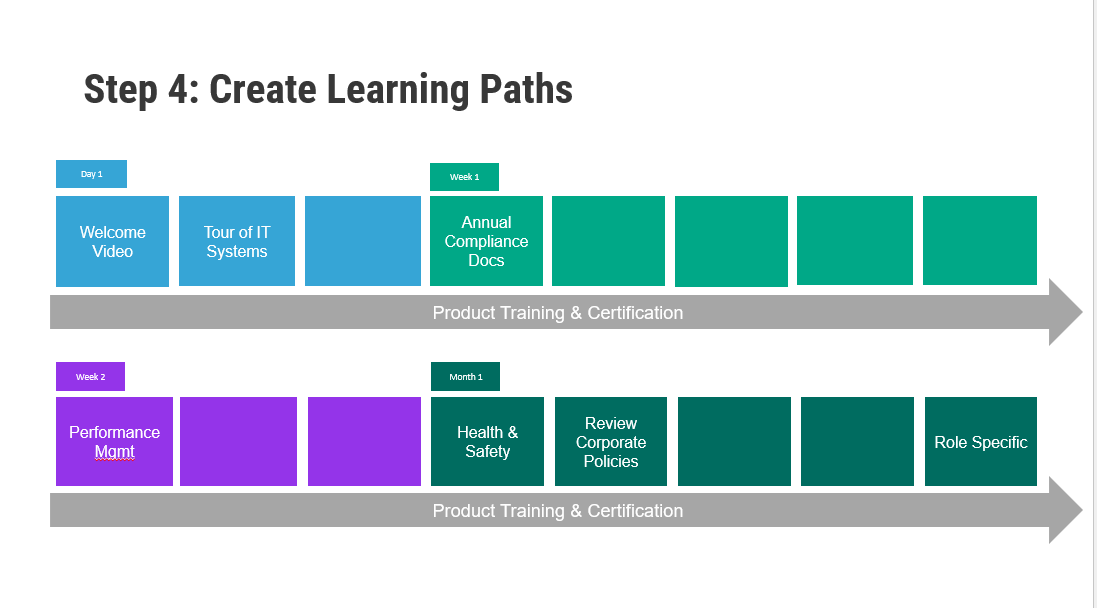An excellent employee onboarding program is crucial to a successful employee-employer relationship. It can improve employee retention by 82 percent and productivity by 70 percent. Failure to create an excellent first impression can have expensive consequences. BambooHR, an HR software provider, surveyed new hires who left a job shortly after their first day. They found that:
- 23% wanted to “receive clear guidelines to what responsibilities”,
- 17% said “a friendly smile or helpful coworker would have made all the difference,” and
- 21% wanted “more effective training”.
Proper employee onboarding and training requires thought, planning and effort, and in this blog, we cover the aspects of a good employee onboarding program.
Employee onboarding definition
Why build a great onboarding program
Difference between orientation and onboarding
Goals of your employee onboarding program
Employee onboarding program best practices
Cost of onboarding a new employee
Onboarding and employee engagement statistics
What research says about learning for employee onboarding
How to set up your learning as employee skills grow
Learning paths for your employee onboarding program
Sample onboarding learning path
Building content for your employee onboarding program
Employee onboarding definition
The term “employee onboarding” refers to the procedure of introducing a new employee to their role, organization, and colleagues. Also known as organizational socialization, it is a crucial element of assisting employees in setting them up for success by providing them with essential information and skills.
A good onboarding program requires input from teams and expert design. Additional considerations should be given when onboarding employees remotely since they don’t have the benefit of being collocated with their teams.
Why build a great onboarding program
A great onboarding process is necessary to get new employees comfortable with their new work environment, help them be productive quickly, and prepare them for a career at an organization. Unfortunately, most companies fail to offer a great first experience.
According to a Gallup study, only 12 percent of employees think their employers do a great job onboarding new employees. The Society for Human Resource Management (SHRM) found that employee turnover can be as much as 50 percent in the first 18 months.
Investing in a comprehensive onboarding program isn’t just beneficial for new employees—it’s an intelligent business strategy. Companies with solid onboarding programs experience higher employee satisfaction, increased productivity, and reduced turnover. By providing clear expectations, ongoing support, and opportunities for growth from day one, organizations can foster a sense of belonging and commitment that leads to long-term success for both the employee and the company.
Difference between orientation and onboarding
Orientation is very transactional. It covers typical HR administrative activities that any organization must do to get someone up and running when they join the organization. These activities include signing papers, reading the health and safety policy, providing them with the hardware they need, etc. Onboarding, on the other hand, is very relational. That means you’re building relationships with the people and the tools you need to perform your job.
Orientation is also only a few hours, or maybe a couple of days, whereas true onboarding is several months up to a year. In that timeframe the new hire will participate in various ongoing learning activities continuously as they also work in the role for which they were hired.
Orientation is typically a one-way communication process where the HR team provides a general overview of the company, including information like the office location, workspace, and necessary paperwork. On the other hand, onboarding is a more personalized process specific to the new hire’s role within the organization. The process is tailored to meet the needs of their department and provide them with the necessary tools and resources to be successful. The goal of onboarding is to help the new hire understand their job responsibilities, learn about company culture, and establish relationships with colleagues.
Orientation should still be part of the onboarding process, but the onboarding program must be longer and broader than just getting the new hire oriented. By providing orientation and onboarding, companies can help new employees feel more comfortable and prepared as they embark on their new career journey.
Goals of your employee onboarding program
The goals of successful onboarding programs may differ slightly from organization to organization, but most onboarding programs typically share similar objectives because the high-level goal of every program is to onboard employees to become effective in their roles.
Successful onboarding programs typically share several common goals. The first is to provide new hires with the necessary tools, knowledge, and relationships to succeed in their new role. Another goal is to acclimate new employees to company culture and values, ensuring a smooth transition into their new role and a desire to stay with the organization long-term.
Consistency is vital. A formal, consistent, and accessible onboarding experience throughout the organization is crucial to its success. Without a formal onboarding process, different departments within the same organization may create their own onboarding experiences, leading to inconsistencies and potentially adverse outcomes. By setting a consistent standard, organizations can ensure that all new hires receive the same high-quality experience, regardless of department or position.
Employee onboarding program best practices
When creating a successful employee onboarding program, certain features are consistently present in the best programs. So, let’s take a closer look at some of the most common features of top-notch onboarding programs that have been deemed excellent and widely shared. By understanding these features, you can implement them in your onboarding program and increase its chances of success.
- Start onboarding as soon as employment is confirmed: As soon as you have a new hire who’s signed that paper, try to find a way to engage them. This doesn’t necessarily mean overwhelming them with information, but it can include sending a welcome video or gift to engage them.
- Provide structured specific road maps (training paths): This helps new hires know what to expect during onboarding, reducing anxiety and improving their overall experience.
- Provide required hardware right away: If they will be coming into the office on that hire date, ensure they have a desk space and that the hardware they need is there. Perhaps get IT to set up the programs that they need.
- Includes social and fun aspects: You want to build a culture that new hires want to be a part of. Including social and fun aspects in the onboarding process can help build a positive culture and foster community within the organization. Even for remote employees, there are lots of ways to engage in remote activities that make them feel included, so it’s all about building those relationships whenever you incorporate those social and fun aspects.
- Assigning mentors and buddies: Assigning mentors and buddies is another great feature that helps create strong relationships and provides valuable support. ·
- Avoid mind-numbing lectures: No one wants to start a new job listening to all the ways the company is great. Make sure you have a variety of self-paced learning, instructor-led training, and fun activities.
- Combine self-paced with instructor-led and practical hands-on training: You want to try and have a variety. Look at the required learning pieces, then choose appropriately when building your path. Combining self-paced with instructor-led and practical hands-on training creates a diverse learning experience that caters to different learning styles.·
- Measure program effectiveness and implement ongoing updates: This is key to ensuring the employee onboarding program meets the organization’s needs and is effective over time. Remember, onboarding is not a “set it and forget it” process but an ongoing initiative that requires evaluation, iteration, updates, and improvement.
Cost of onboarding a new employee
Costs related to onboarding new employees can vary depending on the company size, the seniority of the new employee, the industry, and many other factors.
According to a report by SHRM, the average cost to onboard a new employee is $4,125. ATD estimates it costs $1,252 for managers to train their employees, while onboarding paperwork takes up 10 hours of HR’s time. When calculating the cost of onboarding new employees, consider the following costs:
Phase 1 – Before an employee starts
- Time for HR to create the necessary paperwork
- Time for IT to prepare equipment, such as laptops, phones and home working set up
- Time for IT and administrators to set up digital tools
Phase 2 – The first day
- Time for meetings with HR, supervisor and team members
- Material costs for welcome packs
Phase 3 – The first month
- Time to meet with employees for HR check-ins
- Training time and costs
- Costs for team building activities
Onboarding and employee engagement statistics
Onboarding and employee experience
- The average cost per hire across organizations and industries is $4,125. (SHRM)
- It costs approximately $1,252 for managers to train their employees, while onboarding paperwork takes up 10 hours of HR’s time. (ATD)
- One in five new hires is unlikely to recommend an employer to a friend or family member after their onboarding employee experience. (Digitate)
- Investing more in communication and engagement at the pre-boarding stage can improve the onboarding experience by 83 percent. A quick phone call from the hiring manager boosts a candidate’s excellent experience and desire to continue interacting with the business by 68 percent. (The Talent Board)
- When the manager takes an active role in onboarding, team members are 3.4 times as likely to feel like their onboarding process was successful. (Gallup)
- Organizations with a standard onboarding process experience 50 percent greater new-hire productivity. (SHRM)
- 76 percent of HR professionals reported that their organizations underutilize employee onboarding practices. (Kronos & HCI)
- Only 37 percent of businesses ensure that their onboarding process lasts over a month. (Aberdeen)
- 58 percent of businesses say their onboarding program is centered on processes and paperwork. (Sapling HR)
How onboarding affects retention
- Having a great onboarding for employees can improve employee retention by 82 percent and productivity by 70 percent. (Glassdoor)
- 33 percent of new hires start looking for a new job six months after getting hired, and 23 percent don’t last an entire year. (HCI)
- Employees with a negative new hire onboarding experience are less likely to look for new opportunities soon. (Digitate)
- The most common reason employees leave their jobs is a need for more career development. You can begin informing your new team members about the importance of learning and development at your company during onboarding. Employees who strongly feel they have a clear strategy for professional growth are 3.5 times more likely to describe their onboarding as excellent. (Work Institute)
- Employees who described having a great onboarding experience are 2.6 times more likely to be extremely pleased with their employer. In fact, 70 percent of those with excellent onboarding experiences say they have “the best possible job.” (Gallup)
- New employees with good onboarding experience are 18 times more committed to their employer. (Bamboo HR)
- A strong onboarding process can make you less likely to lose over 60% of your workforce within four years. (TMF Group)
- 69 percent of employees are likelier to stay with a company for three years if they experience great onboarding. (SHRM)
- A survey of over 50,000 employees found that engaged employees are 87 percent less likely to leave a company. They are five times less likely to leave than those who are not engaged. (Inc)
What research says about learning for employee onboarding
Extend the learning window: Studies suggest you extend onboarding programs for at least six months to achieve effective learning saturation. Also, remember that beyond speed to competency, employees are still in the process of “buying in”. In fact, 90% of employees still decide whether to stay at an organization throughout their first six months.
Incorporate learning through others: Including a personalized, 1:1 approach to your extended onboarding program greatly improves learning retention since this is how we, as people, naturally want to learn.
Guide the learning: Just like classroom learning, providing a structure for extended informal or hands-on learning is important. Creating a training path for the onboarding program ensures that learning is continuous and productive, speeding up your new hire’s time to productivity.
Measure impact, iterate, and scale: Once you’ve built and launched your program, it is critical to measure the impact, update it as necessary, and ensure it can scale. Would it be wonderful to have highly individualized, gamified in-person learning for the whole onboarding program? Sure! Will that scale – heck no! You’ve got to have the right mix of fun, information, and standardization to make sure you can scale your program. Include various training types in your program, such as eLearning, instructor-led, videos and knowledge articles, and 1-on-1 sessions, and ensure that the program is repeatable.
How to set up your learning as employee skills grow
Josh Bersin created this Learning in the Flow of Work, which catalyzed the recent buzz around microlearning. The intention was not to replace traditional longer training with microlearning entirely but to show how to use both most effectively.
Early in a role, we need “macro learning” to get started: understanding the job, the domain, the people, and the systems. As we progress up the learning curve, we need continuous injections of new skills, information, and connections to proceed – until we become an expert.
Then, we tend to become the “coach,” teaching others more horizontally until we reach the next level of proficiency, role, or promotion to energize our careers. At that point, we may need another “macro learning” intervention to go back up the learning curve, or if we fail, we may get bored and leave.
Learning paths for your employee onboarding program
A process can be followed to ensure success when creating an employee onboarding learning path for an organization. The first step is determining the roles that require training and the primary business outcomes that need to be achieved with the training.
Onboarding includes everyone in the organization becoming proficient in their roles as quickly as possible. Still, it’s also essential to consider specific outcomes for individuals based on their department or role.
Once the roles and outcomes are established, the high-level tasks and knowledge required for each role are identified and entered into a matrix to look for areas of overlap. These areas of overlap should be the focus at the start of the learning path.
The next step is to create the learning paths. This process can combine experience and collaboration with subject matter experts. It’s important to group tasks together logically and consider a mix of self-paced learning, instructor-led training, and practical hands-on training.
By following this process, organizations can create effective onboarding learning paths that help new hires transition smoothly into their roles and become successful team members.
Sample onboarding learning path
For onboarding, starting with a generic path and then branching off to different roles is easy. The graphic above shows a generic sample path with some standard courses you might find in an onboarding path and some blanks representing other learning pieces.
Providing the visual path is particularly helpful for new hires, especially for the learners, who need to understand what that journey is, what kind of training they’re taking, and when. Typically, as part of a visual path like this, I would also add the training modality (instructor-led, eLearning, knowledge article, etc.) and the length of each learning piece.
Day one is very overwhelming for new hires. You want to keep day one to the essential things they need because they will get acclimated, find their desks, and set up their systems.
In week one, they will need to achieve elements, and then in week two and month one. Once they complete the generic onboarding path that applies to all new hires, the last piece reads “Role Specific.” at that point, new hires should move on to the onboarding path for their role or department to learn the specific that applies to them. This role-specific path may also begin within the first week or two and overlap with the generic path, which I would recommend combining into one view for the new hire.
The last component is what you see in the gray. If you have a complex product or solution, try to sprinkle product/solution training throughout your onboarding.
Check out our employee onboarding template!
Building content for your employee onboarding program
A good employee onboarding program is a great way to empower new hires and increase their chance of success. But building the content for these well-thought-out learning paths can be a real struggle.
LEAi is our online learning content development tool. It helps you quickly create learning content for online courses, step-by-step execution guides, product training, presentations, microlearning, videos, instructor-led training, and more. It imports your PDFs, Word documents, and PowerPoint presentations and creates the training content for you.
If you don’t have the time to build your courses, LearnExperts also offers consulting services that will help you scale the development of learning content so you can quickly engage your new employees, regardless of their roles.
Contact us to learn more about what I presented during the webinar or how we can support your employee onboarding program.

